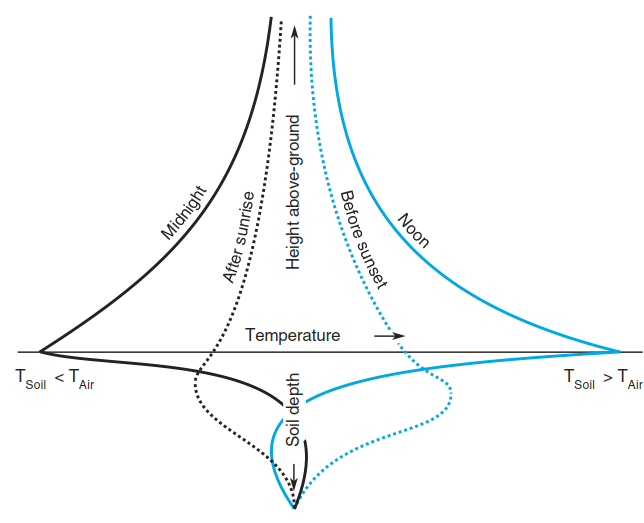Daily Changes in Temperature Near the Ground
As seen in Sect. 9.1, the microclimate at ground level—most relevant to plant life—is regulated by the same processes that are active in the atmosphere. However, larger extremes occur near the ground because of the exchange of energy with the ground, which could be bare soil or the canopy of a plant community (Fig. 9.4). The consequences of short-wave energy absorption and long-wave emission on temperature become most apparent during the daily course of temperatures of bare ground during a clear day (Walter 1960; Gates 1965).
At midnight: The long-wave radiation budget is characterised by high outgoing radiation and low incoming radiation fluxes, which substantially cool the Earth’s surface. The negative radiation budget is partially compensated by heat conduction from the soil and by low heat exchange (via convection due to wind) with the air layers near the soil surface. Formation of dew and hoar frost may partially compensate this effect owing to heat released during condensation and freezing.

Fig. 9.4. Daily course of temperature. Above- and belowground diurnal temperature profiles over bare ground during the course of a day. (After Gates (1965))
During a cloud-free night, temperatures near the ground may fall more than 10 K below the temperature of the atmosphere 2 m above the ground. In the soil, the temperature increases with depth, reaching a time-lagged temperature minimum well after midnight, just before sunrise. At greater depths, the mean temperatures are almost constant (Scheffer 2002). This night-time cooling can limit the distribution of plant species, particularly at sites where diel temperature differences (i.e. over 24 h) can be very large—for example, at alpine elevations or in semi-deserts and deserts.
At sunrise: Incoming solar radiation quickly compensates outgoing net long-wave radiation from the soil surface. Because of the net emission to the atmosphere at night (see above) and the heat transfer into the soil, soil temperatures initially still decrease with depth during the early morning before they rise quickly at shallow depths, driven by air temperature changes, while they approach the mean temperatures of the season at greater soil depths.
At midday: Temperatures at the ground may rise up to 20 K above air temperatures measured 2 m above the ground. Heat transfer is via convection (heating of the atmosphere and development of turbulence) and heat conductance into the soil. The temperature decreases with soil depth and still shows a minimum dependent on the previous night, before reaching the mean temperature of the season at greater depth. These potentially very high temperatures during the day may impair plant regeneration at open sites—for example, after a clear-cut, in a natural forest gap or right after sowing at arable sites.
At sunset: The soil surface temperature decreases with the decreasing incoming radiation, but the temperature within the soil still rises because of the heatwave reaching the deeper soil with a time lag.
Date added: 2025-02-01; views: 418;
